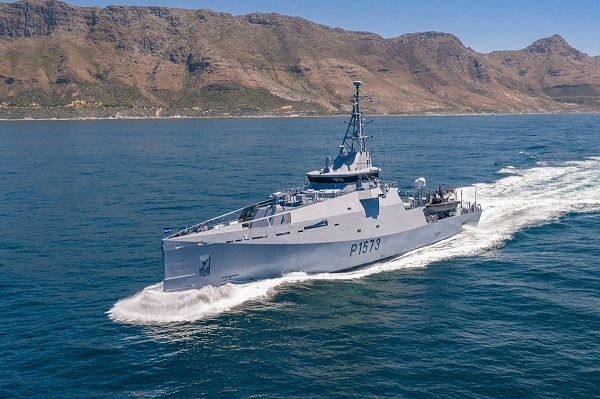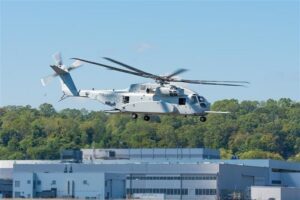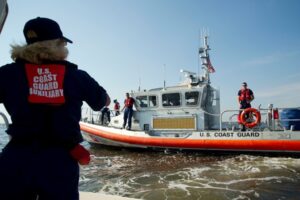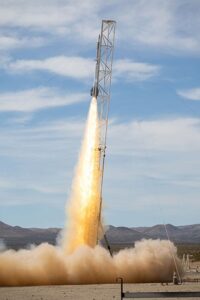DSCT has delivered the third Multi-Mission Inshore Patrol Vessel (MMIPV), P1573, at Naval Base Durban for the South African Navy
The delivery milestone represents the culmination of a strategic initiative by the South African Navy to enhance South Africa’s maritime security, while also advancing local shipbuilding capabilities and driving industrial development.
In a handover ceremony attended by senior South African Naval officials, local government representatives, industry partners, dignitaries, and other key stakeholders, the strategic importance of this vessel and the national significance of the project were appropriately celebrated.
Sefale Montsi, Director at Damen Shipyards Cape Town, explained that the delivery of P1573 represents far more than the delivery of a vessel – it marks the fulfilment of a promise. “From the outset, our commitment was clear: to support the South African Navy, empower the local shipbuilding industry, and enhance maritime security. With this delivery, we are proud to have honoured that commitment.”
A model for collaboration: DSCT, the Navy, and ARMSCOR
The delivery of P1573 followed a formal handover in Simon’s Town in March 2025, where the vessel passed stringent technical and quality inspections. The project was driven by close collaboration between DSCT, the South African Navy, and ARMSCOR, aligning with the Department of Defence’s broader strategy to modernise and expand fleet capabilities.
“This project has exemplified the power of collaboration – within DSCT, across our supplier base, and most importantly, with our partners in the Navy and ARMSCOR,” explained Montsi. “Everyone involved has reason to be proud.”
Boosting maritime security along a strategic coastline
P1573 joins sister vessels P1571 and P1572 in the Navy’s patrol squadron based in Durban. These vessels were purpose-built to safeguard South Africa’s 2,700-kilometre coastline – an economic lifeline that carries more than 90% of the country’s trade by volume, and borders the increasingly critical Cape Sea Route.
Designed for endurance, versatility, and operational excellence, the MMIPVs feature Damen’s patented Axe Bow design for superior seakeeping. Each vessel is armed with a 20mm Super Sea Rogue gun, equipped with advanced FORT (Frequency Modulated Optical Radar Tracker) surveillance technology, and includes 7m and 7.5m interceptor boats for rapid deployment.
“These vessels are built for performance and versatility. Whether it’s needed for border protection, search and rescue, diving operations, or training missions, they significantly expand the Navy’s operational reach,” added Montsi.
Project Biro: A catalyst for local industry and skills development
Commissioned by the Department of Defence and managed by ARMSCOR, Project Biro set out to enhance South Africa’s inshore patrol capability while building local industrial growth. DSCT was appointed for the project based on its global expertise and strong commitment to localisation. However, the project’s impact extended far beyond shipbuilding; it spurred substantial economic and skills development benefits nationwide.
More than 1,000 direct jobs and over 4,000 indirect jobs were created, with DSCT partnering with 848 local vendors. This significantly bolstered South Africa’s maritime value chain and transferred critical shipbuilding knowledge to local hands.
A key pillar of the project was DSCT’s on-site Skills Development Centre, where over 50 apprentices were trained in essential trades such as welding, outfitting, electrical systems, pipe-fitting, and logistics.
“We haven’t just built ships, but skills, livelihoods, and a foundation for a globally competitive shipbuilding sector,” said Montsi. “That’s the enduring legacy of Project Biro.”
Industrial participation: Creating lasting impact beyond the shipyard
A defining feature of Project Biro has been its alignment with South Africa’s National and Defence Industrial Participation frameworks. From the outset, DSCT embedded enterprise development, skills transfer, and local sourcing into every stage of the programme, demonstrating that advanced shipbuilding and inclusive economic growth can be achieved in tandem. As a result, the project not only enhanced local manufacturing capacity but also contributed to embedding sovereign industrial capabilities within the national defence ecosystem.
Moreover, through their involvement in Project Biro, several South African entities gained access to Damen’s global supply chain, leading to follow-on export contracts and participation in international projects.
“This global exposure has opened doors for sustained growth beyond South Africa’s borders,” explained Christopher Huvers, Sales Director at DSCT. “We are proud to have significantly exceeded our industrial participation objectives, reflecting a genuine commitment to long-term impact rather than compliance alone. As part of Damen’s broader philosophy, this approach continues to serve as a catalyst for sustainable economic empowerment and resilience in the South African maritime industry.”
Charting the course ahead: Continued commitment to maritime excellence
With all three vessels now delivered, DSCT has committed to providing ongoing logistical and technical support, including training, spare parts, and maintenance assistance to ensure operational readiness.
Building on its track record, which includes the successful delivery of two harbour tugs under Project Canter and involvement in regional defence programmes, DSCT reaffirmed its readiness to support future Navy requirements.
“We’re ready to build more ships for South Africa. We have the infrastructure, the skilled workforce, and a proven track record that highlights the capabilities of our local shipbuilding industry,” added Jos Govaarts, Managing Director at DSCT. “Project Biro has shown that South Africa can deliver cutting-edge naval vessels that meet international standards, while uplifting local communities and driving industrial growth. We stand ready to support the Navy’s evolving needs and help shape the future of maritime defence.”







